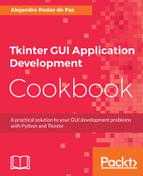Our ttk.Notebook widget is created with a specific width and height, as well as an external padding.
Each key from the todos dictionary is used as the name of a tab, and the list of values is added as labels to ttk.Frame, which represents the window region:
self.notebook = ttk.Notebook(self, width=250, height=100, padding=10)
for key, value in todos.items():
frame = ttk.Frame(self.notebook)
self.notebook.add(frame, text=key,
underline=0, sticky=tk.NE+tk.SW)
for text in value:
ttk.Label(frame, text=text).pack(anchor=tk.W)
After this, we call enable_traversal() on the ttk.Notebook widget. This allows users to switch tabs back and forth between tab panels using Ctrl + Shift + Tab and Ctrl + Tab, respectively.
It also enables switching into a specific tab by pressing Alt and the underlined character, that is, Alt + H for the Home tab, Alt + W for the Work tab, and Alt + V for the Vacation tab.
The "<<NotebookTabChanged>>" virtual event is generated when the tab selection changes, and we bind it to the select_tab() method. Note that this event is automatically raised when Tkinter adds a tab to ttk.Notebook:
self.notebook.pack()
self.label.pack(anchor=tk.W)
self.notebook.enable_traversal()
self.notebook.bind("<<NotebookTabChanged>>", self.select_tab)
When we pack the items, it is not necessary to place the ttk.Notebook child windows since it is internally done by the ttk.Notebook call to the geometry manager:
def select_tab(self, event):
tab_id = self.notebook.select()
tab_name = self.notebook.tab(tab_id, "text")
self.label.config(text=f"Your current selection is: {tab_name}")
